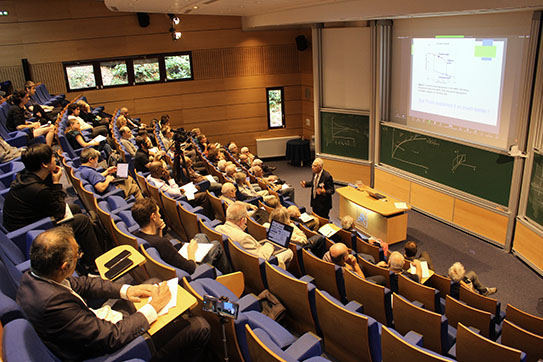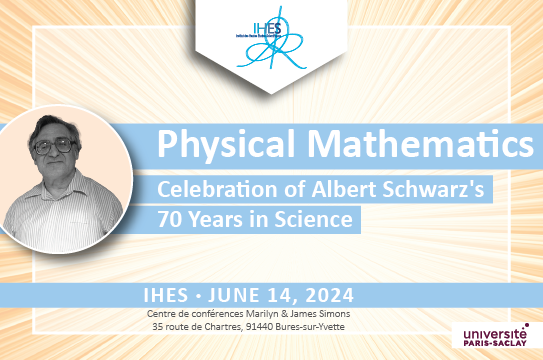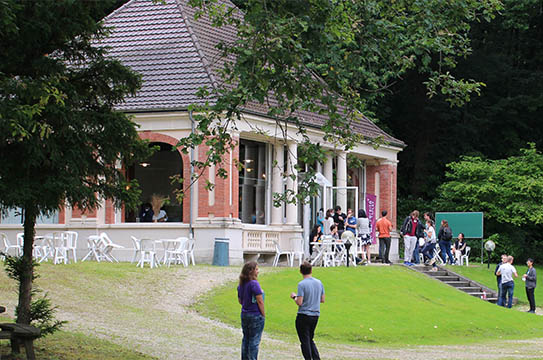 IHES
IHES
Looking back at the conference celebrating René Thom
2023 marks the centenary of the birth of René Thom, one of the two 1958 Fields medalists, who served as a permanent professor at IHES from 1963 to 1988 and profoundly influenced not only mathematics but science as a whole.
To celebrate René Thom’s life and work, the French Academy of Sciences held a public event on September 19th, followed by a 3-day scientific program at IHES from September 20th to 22nd.
The broad range of invited speakers in mathematics showcased how René Thom’s ideas shaped 20th-century mathematics and continue to inspire research today.
While many lectures naturally focused on different aspects of singularity theory (as discussed in the lectures by N. A’Campo, K. Kurdyka, D. Sullivan, and B. Teissier) and dynamical systems (as discussed in the lectures by A. Chenciner, and A. Rechtman), it was also shown how the notions of cobordism and transversality are now being adapted to the categorical setting to answer questions from quantum topological field theory, a particularly active research area in mathematical physics (as discussed in the lecture by O. Randal-Williams).
A less well-known fact is that René Thom developed the notion of “partial differential relation” in his 1949 paper “Sur une partition en cellules associée à une fonction sur une variété”. His work was picked up in the 1980s by Misha Gromov, whose famous h-principle revolutionized the study of non-linear partial differential equations (as discussed in the lecture by E. Giroux). M. Gromov was a permanent professor at IHES from 1982 to 2015 and is now emeritus.
Finally, Ivar Ekeland showed how René Thom’s ideas might help us overcome the limitations of optimization in the analysis of models coming from climate science.
Furthermore, René Thom’s influence is not only confined to mathematics. His book “Structural Stability and Morphogenesis” had a major impact on the development of theoretical biology in the 1970’s (as discussed in the lecture by A. Danchin). His approach to scientific modeling, and his correspondence with C.H. Waddington are now objects of study in the philosophy of science (as discussed in the lectures by S. Franceschelli, and J. Petitot). Contrary to the mathematicians affiliated to the Bourbaki collective, images were always important for Thom’s thinking. They not only provided him with conceptual hints but also, as in the case of Waddington’s ‘Epigenetic Landscape’, helped him define a research agenda in theoretical biology.
More surprisingly, Thom’s catastrophe theory also provided the conceptual framework in chemistry for Richard Bader’s quantum theory of atoms in molecules (as discussed in the lecture by C. Matta). Since the 19th century, chemists have been interested in atomic bond paths in molecules. These bond paths may undergo sudden changes during a chemical reaction. Understanding these changes as catastrophes helped Bader gain new insights into molecular structure.
Recently, Thom’s ideas were also applied in psychology, visual arts, and music (as discussed in lectures by D. Bennequin, and W. Wildgen).
On a more personal level, a souvenir session was organized, including interviews and film extracts. This session not only allowed conference participants to effectively hear and see René Thom but also provided an opportunity for some who knew Thom personally to share their stories and reminiscences.
In 2011, the late André Haefliger suggested that Thom’s collected works should include his correspondence. Thanks to the dedicated efforts of Marc Chaperon and the editorial team, the three volumes of his collected works are now published by the French Mathematical Society (also available for purchase via the AMS). In addition to his scientific papers and correspondence, the books also feature commentaries by Alain Chenciner, François Laudenbach, Jean Petitot, Bernard Teissier, and David Trotman.
Videos of all lectures will be available soon on carmin.tv.



